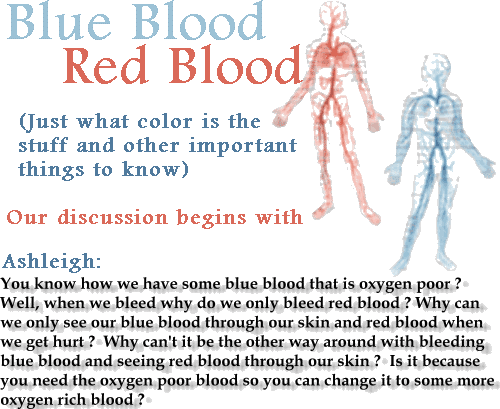Heather and Ashleigh: 
January 13, 1997
Dear Mr. D Hi!! How are you? We are fine. We as in Heather
and Ashleigh.
Heather: Thanks for writing back
to us. How was your weekend? I lost that calorie info so tonight
I will print it out again. Ashleigh is going to call and remind me. How
come your blood looks blue but isn't blue?
|
| Mr. D: Your *blood* does
not ever *look* blue. The blue things you see under your skin are
veins. Veins are really whitish in color but because the blood is
dark and the skin difuses the light, the veins *look* blue.
|
| Ashleigh: Thank you again for writing
back. Thank you for the answers. I will tell Mr. Johnson
about this. I do not even know if he knows about the blood thing.
I like the way you think too.
|
| Heather: So when you bleed the blue
blood does not meet the air and turn red ?
|
| Mr. D: No, the dark red blood
*may* pick up a little oxygen and brighten up a slight bit, but your blood
is *never* blue.
|
| Ashleigh: I forgot to say something
: Thank you for all of the technical talk. (Ha Ha) You could
have just said veins instead of venous and arteries instead of arterial
but that is okay. I was just telling you that.
|
Sorry this letter isn't as long but we have to go to class.
Your tired Keypals,
Heather and
Ashleigh
|
| Mr. D: Thanks for writing.
You both brighten my day.
|
January 15, 1997
Heather: I think I understand about
the veins and blood.
|
| Mr. D: Are
you sure?
|
| Ashleigh: Okay, so your veins are
really a whitish color. Right ? So if your veins aren't the
color we see, arteries are red right? Doctors see that the arteries
are red or are they a different color too ? I will translate this
to you: Are the arteries the color we think they are (red) or are
they a different color ?
|
| Mr. D: Actually the veins
and arteries look similar when you remove the skin and can see them directly.
Veins are a slightly more "bluish" white and the walls are thinner
than arteries. Arteries, since they are a *high pressure* system
pulsate (this is what you feel when you check your pulse).
|

 Heather:
Heather:
